Jason Schneider
the Camera Collector
Konica FT-1 Pro Half Review
A hands-on evaluation of the rare half frame variant of the Konica FT-1
By Jason Schneider
The Konica FT-1 Pro Half is a very rare half frame iteration of the motorized, electronically controlled Konica FT-1 of 1983-1987, the last 35mm SLR Konica built in its own factories and under its own name. (FYI, the very last Konica SLR was the elemental but charming plastic bodied, entry level Konica TC-X made for Konica by Cosina.) Released in 1985, the FT-1 Pro Half was never officially advertised or marketed internationally, or sold through normal retail channels, except for a small number that were made available to retailers in Japan. Based on one Japanese seller’s recent eBay listing for a “mint in box” Pro Half that includes images of an official Konica FT-1 Pro Half box and price tag, the camera (body only) retailed for ¥95,000, or a whopping $638.68, back in 1985, Just for giggles, this is equal to a staggering $1,692.50 in 2022 U.S. dollars, somewhat higher than the camera’s actual selling price of one red cent shy of 1400 bucks! Was it a premium edition aimed at pros as its name suggests? Possibly. However, most of these cameras, all in an attractive bright satin chrome finish, were evidently given as special gifts to corporate customers, executives, and friends of the company. There are no official production figures either, but it’s doubtful that more than a few hundred Pro Half cameras were made.
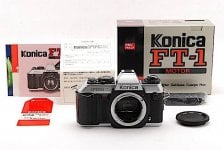
Konica FT-1 Pro Half with original box, manual and price tag. Its retail price of ¥95,000, body only, placed it in the top tier of 35mm SLRs and few were sold in stores.
Was the FT-1 Pro Half intended as a special limited production run or was it a camera that was originally slated for full production before they pulled the plug? Probably the former, but nobody we’ve contacted knows for sure. However, it’s worth noting that Konica had a long dalliance with half frame cameras. Examples: the Konica Eye of 1964 and Eye 2 of 1967, both autoexposure, scale focusing compacts; the Konica Auto-Reflex of 1965, a landmark SLR that provides shutter priority autoexposure and metered manual via an external CdS cell, and can shoot interspersed half- and full-frame images on the same roll (!), and the brilliant but clunky Konica IIIM rangefinder 35 of 1959 which has parallax compensating viewfinder frame lines for full- and half-frame formats, a notoriously unreliable flip-up selenium meter cell, and came with a separate half-frame mask that could be inserted in the film gate, thus precluding mid-roll format switching.
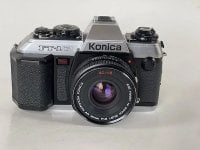
Our test camera: A pristine Konica FT-1 Pro Half with superb 40mm f/1.8 Hexanon lens, and rare alternative grip that holds 4 higher capacity AA batteries.
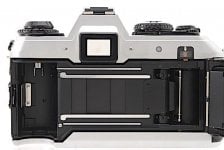
Rear view of Pro Half shows original full frame casting masked down with thin metal strips on both sides to provide 18 x 24mm half frame format.
The standard issue Konica FT-1 is essentially a modernized, upgraded replacement for the Konica FS-1 of 1979-1982, with a new, improved silicon photodiode metering system, enhanced electronics, and a faster motor wind speed. Its outer body is polycarbonate, but it’s coated in a durable black or bright satin chrome finish that has a nice metallic feel. Various controls were relocated, including the ISO dial, on-off switch, and self-timer. Newly added controls include an exposure compensation scale next to the ISO dial, a switch to toggle between single shot (S) and continuous (C) advance at up to 2 fps, a back-mounted “rotating line” film advance indicator, a self-timer LED, a vertical aperture display LED array on the lef-hand side of the finder, and a covered 5-contact accessory terminal for dedicated Konica accessories. Like Konica’s first SLR, the landmark pro caliber Konica F of 1960, the FT-1 has a vertical travel metal focal plane shutter, but unlike the one in the F it’s not an ingenious but finicky shutter with a top speed of 1/2000 sec, but a conventional Copal unit that provides speeds of 2-1/1000 sec plus B. Like the FS-1 The FT-1 uses Konica’s brilliant “lay the leader on the take-up roller” auto-load system and its standard Konica AR mount accepts Konica’s full lime of superlative line of Hexanon lenses.
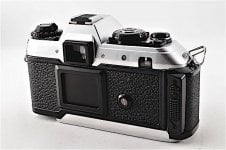
Rear view of Konica FT-1 Pro Half with back closed shows round film wind indicator to the right of film box end clip, 72-exposure frame counter on upper right.
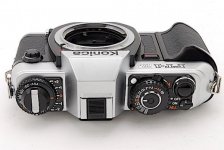
Top view of Pro Half shows AEL (autoexposure lock) mode setting and S (single frame) and and C (continuous) motor drive settings behind shutter release.
Measuring a compact 5.6 x 3.6 x 1.8 inches (W x H x D) and weighing in at a moderately hefty 20.1 ounces (body only without batteries) thanks to its built-in motor drive, and weighing in at 26.1 ounces with 50mm f/1.8 lens, the sleekly styled, ergonomically contoured FT-1 Pro Half is very well balanced and, as the Brits would say, its controls “fall readily to hand.” It closely resembles the standard FT-1 and were it not for the nice silver “Pro Half” decal slapped over (?) the word “MOTOR” engraved in orange letters to the right of the FT-1 logo on the front of the top plate, you could easily mistake one for the other. Only by carefully examining the additive frame counter on the upper right-hand part of the back and noticing that there are dots in between a sequence of even numbers does it become clear that this is not a standard FT-1. The frame counter and internal gearing have been modified to advance and count the film one 18 x 24mm frame at a time, and of course the counter tops out at 72 frames rather than the usual 36, at which point a red LED to the left of the counter lights up to remind you to press in the rewind button on the bottom of the camera and rewind the film manually using the folding rewind crank.
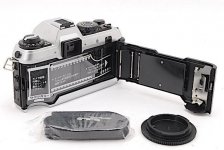
Konica FT-1 Pro Half with original packing shows dummy auto load "film strip" with easy loading instructions in Japanese. It's a breeze!
Open the back of the Pro Half to load it, and you’re greeted by a film aperture (aka film gate) that’s been modified to provide the 18 x 24mm format by masking down the 24 x 36mm frame with thin metal blanking strips on the left- and right-hand sides, just inboard of the film aperture plate. It’s an effective solution, but it differs from the approach taken by Pentax, Alpa, and Leica, all of which provided entirely new film gate castings for their half frame models. It also suggests that the Pro Half was indeed a limited-edition variant that was never intended for full production. To load the Pro Half (or the standard FT-1) just lay the film leader across a thin metal spindle next to the rubberized take-up roller, making sure that its end contacts the roller and close the back. Presto, the film is automatically advanced to frame 1 and the wind indicator line rotates to confirm that the film is advancing. Brilliant!
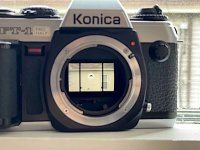
View through open lens mount of Pro Half shows reflected, upside down image of the finder screen. The vertical frame lines defining the 18 x 24mm half frame format have stubby protrusions that point inward, toward the center of the frame. These "guide marks" appear near the top when looking though the finder.
The final and most emphatic confirmation that you’re shooting with a Pro Half comes when you lift the camera to your eye. Like the standard issue FT-1, the bright, contrasty focusing screen of this pentaprism SLR has a central, horizontally oriented split image rangefinder surrounded by a thick microprism collar and a full focusing outer area. The only difference is that the Pro Half’s screen is inscribed with 2 thickish vertical lines that divide the standard 24 x 36mm viewing field into 3 distinct areas—a central 18 x 24mm area delineating the half frame capture area, framed by thin 9 x 24mm areas on the left and right-hand sides. By adopting the simple cost-efficient strategy of modifying the existing screen and using the same pentaprism viewing system for both models, Konica achieved something very special—it’s the only 35mm SLR that lets you see beyond the image capture area on both sides so you can see and anticipate laterally moving action subjects before they enter the area being recorded on film. Long one of the vaunted advantages of multi-frame rangefinder 35s like M-series Leicas, the Pro Half is the only SLR to my knowledge that has this capability (Alpas, Praktinas,and other SLRs with built-inauxiliary optical finders don’t really qualify.

Halloween party portrait: shot with Pro Half, 40mm f/1.8 Hexanon lens on Fuji Acros II 100 film.

Three costumed party girls: shot with Pro Half and 40mm f/1.8 Hexanon lens on Fuji Acros II 100 film.
Another quirk of Konica’s execution is that both the vertical lines inscribed on the Pro Half’s viewing screen have little nubbins located about 4/5 of the way up their height each “pointing” inward toward the half frame capture area. Without a user manual (evidently there was one), I can’t be certain, but I surmise these little protuberances act as “subliminal cues” to direct the eye toward the central capture area. My only criticism of Konica’s otherwise brilliant execution is that the half frame format lines are thicker than they need be and obscure a tiny portion of the viewing area, but at least nobody picking up this camera will be confused about what it is or what it does. If you’re going to design a half frame SLR based on an existing camera, the FT-1 with its built-in winder with single-frame (S) 2 fps (C or continuous) options, plus auto loading is a great place to start. And if 72 exposures per roll seems like a lot, at least it answers the jibes of DSLR fans who frequently shed crocodile tears for us poor benighted analog shooters that are limited to “only” 36 shots per roll.

Glenda: impromptu portrait was shot with Konica Pro Half with 40mm f/1.8 Hexanon lens on Fuji Acros II 100 film,
Overall, shooting with the Konica FT-1 Pro Half is a blast. It has the feel and heft of a high-quality camera, its controls are logically arrayed and easily accessible, its electromagnetic shutter release is smooth and predictable, and its motor advance and shutter action are reasonably quiet. For a manual focus, mechanical 35mm SLR the camera is commendably responsive, and its vertical in-finder aperture scale with LED dot readouts is easy to see in virtually any light. Per standard Konica SLR practice, the Pro Half provides shutter priority AE (with the lens set to AE) and metered manual exposure, and its silicon cell metering system delivers TTL center-weighted readings. We found the system to be accurate to well within half a stop in a wide variety of lighting conditions and is sensitive enough to read in low light (down to EV 0.7 at ISO 100 (which corresponds to f/1.8 at 2 sec) and up to EV 19 (f/22 at 1/1000 sec). It also provides a clear warning (flashing LEDs) of under-and overexposure. It is also (along with the standard FT-1) the only Konica SLR that provides an AEL setting which lets you lock in the exposure by partially depressing the shutter release, a great convenience when shooting in backlit or tricky lighting conditions. For the record the FT-1 Pro Half, like its full frame sire, is powered by 4 AAA alkaline batteries contained in its compact comfortably contoured righthand grip. The official FT-1spec sheet says that’s sufficient to move 10 36-exposure rolls through the camera, so presumably it will do the same for at least 5 72-exposure rolls in the Pro Half. There was also a larger 4 AA grip capable of running 40 36-exposure rolls through the FT-1, and it will also fit the Pro Half, but good luck finding one.
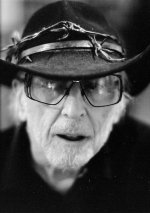
Portrait of the artist: Konica FT-1 Pro Half with 57mm f/1.2 Hexanon lens, wide open, on Fuji Acros II 100 film.

Ezra: shot with Konica FT-1 Pro Half and 57mm f/1.2 Hexanon lens, wide open, on Fuji Acros II 100 film.
The Konica FT-1 Pro Half is an extremely nice camera, maybe even a great one if you like 35mm SLRs and you’re into half frame. I was very pleased with the on-film performance of my borrowed Pro Half, and I’ve included some selected images here that (I hope) will show you why. Of course, you’ve got to live with the fact that most normal lenses effectively become moderate telephotos when shooting on the half frame format (the 28mm f/2.8 Hexanon is the closest thing to the 30mm normal lens you’re likely to find). Also, the camera shoots verticals when held normally and must be turned on its side to shoot horizontals, which can take some getting used to. But by far the biggest challenge to acquiring a Pro Half is the “collectors” price, which currently ranges from $900-$1,400 body only—if you can even find one offered for sale. You could of course opt for a standard issue full frame Konica FT-1, but a guaranteed fully working example in black or chrome will set you back about $150-$200. The weak points of either model: dodgy electronics that can be a bear to repair, and battery contact corrosion when you leave used batteries in the grip. Whatever you do, don’t buy a regular full frame FT-1 that’s not working, “not tested” (which usually means the same thing) or non-returnable. They’re lovely examples of the final chapter of analog era, but they’re not without their foibles. The good news: you can acquire a non-working Konica FT-1 for a pittance and (except for the finder screen and frame counter mechanism) all parts are interchangeable.

Aster the birthday girl, age 7: shot with Pro Hall with 40mm f/1.8 Hexagon lens on Fuji Acros II 100 film.

Besties: shot with Pro Half and 40mm f/1.8 lens on Fuji Acros II 100 film.
Now the million-dollar question – how does the Konica FT-1 Pro Half stack up against the longtime kings of half frame SLRs – the legendary Olympus Pen F (1963-1966) FT (1966-1972) and FV (1967-1970)?? Answer: amazingly well. The Pro Half delivers a far better, much faster, more convenient shooting experience than the Olympus SLR half frame system thanks to its seamless integration, AE mode, and built-in motor drive. Its viewfinder is better and brighter, its TTL metering system is superior, and its ergonomic form factor is a delight. Still, Maitani’s classic F-series half frame SLRs offer a better choice of fast glass than the Pro Half. It does make one yearn for the long rumored but mythical Olympus OM-1 half frame – which I’m guessing must have been made at least in secret prototype form. Wait! I see one on my shelf. All I need to do is block off half the finder and insert a half frame mask behind the shutter and I’m there….at least in my dreams.
A hands-on evaluation of the rare half frame variant of the Konica FT-1
By Jason Schneider
The Konica FT-1 Pro Half is a very rare half frame iteration of the motorized, electronically controlled Konica FT-1 of 1983-1987, the last 35mm SLR Konica built in its own factories and under its own name. (FYI, the very last Konica SLR was the elemental but charming plastic bodied, entry level Konica TC-X made for Konica by Cosina.) Released in 1985, the FT-1 Pro Half was never officially advertised or marketed internationally, or sold through normal retail channels, except for a small number that were made available to retailers in Japan. Based on one Japanese seller’s recent eBay listing for a “mint in box” Pro Half that includes images of an official Konica FT-1 Pro Half box and price tag, the camera (body only) retailed for ¥95,000, or a whopping $638.68, back in 1985, Just for giggles, this is equal to a staggering $1,692.50 in 2022 U.S. dollars, somewhat higher than the camera’s actual selling price of one red cent shy of 1400 bucks! Was it a premium edition aimed at pros as its name suggests? Possibly. However, most of these cameras, all in an attractive bright satin chrome finish, were evidently given as special gifts to corporate customers, executives, and friends of the company. There are no official production figures either, but it’s doubtful that more than a few hundred Pro Half cameras were made.

Konica FT-1 Pro Half with original box, manual and price tag. Its retail price of ¥95,000, body only, placed it in the top tier of 35mm SLRs and few were sold in stores.
Was the FT-1 Pro Half intended as a special limited production run or was it a camera that was originally slated for full production before they pulled the plug? Probably the former, but nobody we’ve contacted knows for sure. However, it’s worth noting that Konica had a long dalliance with half frame cameras. Examples: the Konica Eye of 1964 and Eye 2 of 1967, both autoexposure, scale focusing compacts; the Konica Auto-Reflex of 1965, a landmark SLR that provides shutter priority autoexposure and metered manual via an external CdS cell, and can shoot interspersed half- and full-frame images on the same roll (!), and the brilliant but clunky Konica IIIM rangefinder 35 of 1959 which has parallax compensating viewfinder frame lines for full- and half-frame formats, a notoriously unreliable flip-up selenium meter cell, and came with a separate half-frame mask that could be inserted in the film gate, thus precluding mid-roll format switching.

Our test camera: A pristine Konica FT-1 Pro Half with superb 40mm f/1.8 Hexanon lens, and rare alternative grip that holds 4 higher capacity AA batteries.

Rear view of Pro Half shows original full frame casting masked down with thin metal strips on both sides to provide 18 x 24mm half frame format.
The standard issue Konica FT-1 is essentially a modernized, upgraded replacement for the Konica FS-1 of 1979-1982, with a new, improved silicon photodiode metering system, enhanced electronics, and a faster motor wind speed. Its outer body is polycarbonate, but it’s coated in a durable black or bright satin chrome finish that has a nice metallic feel. Various controls were relocated, including the ISO dial, on-off switch, and self-timer. Newly added controls include an exposure compensation scale next to the ISO dial, a switch to toggle between single shot (S) and continuous (C) advance at up to 2 fps, a back-mounted “rotating line” film advance indicator, a self-timer LED, a vertical aperture display LED array on the lef-hand side of the finder, and a covered 5-contact accessory terminal for dedicated Konica accessories. Like Konica’s first SLR, the landmark pro caliber Konica F of 1960, the FT-1 has a vertical travel metal focal plane shutter, but unlike the one in the F it’s not an ingenious but finicky shutter with a top speed of 1/2000 sec, but a conventional Copal unit that provides speeds of 2-1/1000 sec plus B. Like the FS-1 The FT-1 uses Konica’s brilliant “lay the leader on the take-up roller” auto-load system and its standard Konica AR mount accepts Konica’s full lime of superlative line of Hexanon lenses.

Rear view of Konica FT-1 Pro Half with back closed shows round film wind indicator to the right of film box end clip, 72-exposure frame counter on upper right.

Top view of Pro Half shows AEL (autoexposure lock) mode setting and S (single frame) and and C (continuous) motor drive settings behind shutter release.
Measuring a compact 5.6 x 3.6 x 1.8 inches (W x H x D) and weighing in at a moderately hefty 20.1 ounces (body only without batteries) thanks to its built-in motor drive, and weighing in at 26.1 ounces with 50mm f/1.8 lens, the sleekly styled, ergonomically contoured FT-1 Pro Half is very well balanced and, as the Brits would say, its controls “fall readily to hand.” It closely resembles the standard FT-1 and were it not for the nice silver “Pro Half” decal slapped over (?) the word “MOTOR” engraved in orange letters to the right of the FT-1 logo on the front of the top plate, you could easily mistake one for the other. Only by carefully examining the additive frame counter on the upper right-hand part of the back and noticing that there are dots in between a sequence of even numbers does it become clear that this is not a standard FT-1. The frame counter and internal gearing have been modified to advance and count the film one 18 x 24mm frame at a time, and of course the counter tops out at 72 frames rather than the usual 36, at which point a red LED to the left of the counter lights up to remind you to press in the rewind button on the bottom of the camera and rewind the film manually using the folding rewind crank.

Konica FT-1 Pro Half with original packing shows dummy auto load "film strip" with easy loading instructions in Japanese. It's a breeze!
Open the back of the Pro Half to load it, and you’re greeted by a film aperture (aka film gate) that’s been modified to provide the 18 x 24mm format by masking down the 24 x 36mm frame with thin metal blanking strips on the left- and right-hand sides, just inboard of the film aperture plate. It’s an effective solution, but it differs from the approach taken by Pentax, Alpa, and Leica, all of which provided entirely new film gate castings for their half frame models. It also suggests that the Pro Half was indeed a limited-edition variant that was never intended for full production. To load the Pro Half (or the standard FT-1) just lay the film leader across a thin metal spindle next to the rubberized take-up roller, making sure that its end contacts the roller and close the back. Presto, the film is automatically advanced to frame 1 and the wind indicator line rotates to confirm that the film is advancing. Brilliant!

View through open lens mount of Pro Half shows reflected, upside down image of the finder screen. The vertical frame lines defining the 18 x 24mm half frame format have stubby protrusions that point inward, toward the center of the frame. These "guide marks" appear near the top when looking though the finder.
The final and most emphatic confirmation that you’re shooting with a Pro Half comes when you lift the camera to your eye. Like the standard issue FT-1, the bright, contrasty focusing screen of this pentaprism SLR has a central, horizontally oriented split image rangefinder surrounded by a thick microprism collar and a full focusing outer area. The only difference is that the Pro Half’s screen is inscribed with 2 thickish vertical lines that divide the standard 24 x 36mm viewing field into 3 distinct areas—a central 18 x 24mm area delineating the half frame capture area, framed by thin 9 x 24mm areas on the left and right-hand sides. By adopting the simple cost-efficient strategy of modifying the existing screen and using the same pentaprism viewing system for both models, Konica achieved something very special—it’s the only 35mm SLR that lets you see beyond the image capture area on both sides so you can see and anticipate laterally moving action subjects before they enter the area being recorded on film. Long one of the vaunted advantages of multi-frame rangefinder 35s like M-series Leicas, the Pro Half is the only SLR to my knowledge that has this capability (Alpas, Praktinas,and other SLRs with built-inauxiliary optical finders don’t really qualify.

Halloween party portrait: shot with Pro Half, 40mm f/1.8 Hexanon lens on Fuji Acros II 100 film.

Three costumed party girls: shot with Pro Half and 40mm f/1.8 Hexanon lens on Fuji Acros II 100 film.
Another quirk of Konica’s execution is that both the vertical lines inscribed on the Pro Half’s viewing screen have little nubbins located about 4/5 of the way up their height each “pointing” inward toward the half frame capture area. Without a user manual (evidently there was one), I can’t be certain, but I surmise these little protuberances act as “subliminal cues” to direct the eye toward the central capture area. My only criticism of Konica’s otherwise brilliant execution is that the half frame format lines are thicker than they need be and obscure a tiny portion of the viewing area, but at least nobody picking up this camera will be confused about what it is or what it does. If you’re going to design a half frame SLR based on an existing camera, the FT-1 with its built-in winder with single-frame (S) 2 fps (C or continuous) options, plus auto loading is a great place to start. And if 72 exposures per roll seems like a lot, at least it answers the jibes of DSLR fans who frequently shed crocodile tears for us poor benighted analog shooters that are limited to “only” 36 shots per roll.

Glenda: impromptu portrait was shot with Konica Pro Half with 40mm f/1.8 Hexanon lens on Fuji Acros II 100 film,
Overall, shooting with the Konica FT-1 Pro Half is a blast. It has the feel and heft of a high-quality camera, its controls are logically arrayed and easily accessible, its electromagnetic shutter release is smooth and predictable, and its motor advance and shutter action are reasonably quiet. For a manual focus, mechanical 35mm SLR the camera is commendably responsive, and its vertical in-finder aperture scale with LED dot readouts is easy to see in virtually any light. Per standard Konica SLR practice, the Pro Half provides shutter priority AE (with the lens set to AE) and metered manual exposure, and its silicon cell metering system delivers TTL center-weighted readings. We found the system to be accurate to well within half a stop in a wide variety of lighting conditions and is sensitive enough to read in low light (down to EV 0.7 at ISO 100 (which corresponds to f/1.8 at 2 sec) and up to EV 19 (f/22 at 1/1000 sec). It also provides a clear warning (flashing LEDs) of under-and overexposure. It is also (along with the standard FT-1) the only Konica SLR that provides an AEL setting which lets you lock in the exposure by partially depressing the shutter release, a great convenience when shooting in backlit or tricky lighting conditions. For the record the FT-1 Pro Half, like its full frame sire, is powered by 4 AAA alkaline batteries contained in its compact comfortably contoured righthand grip. The official FT-1spec sheet says that’s sufficient to move 10 36-exposure rolls through the camera, so presumably it will do the same for at least 5 72-exposure rolls in the Pro Half. There was also a larger 4 AA grip capable of running 40 36-exposure rolls through the FT-1, and it will also fit the Pro Half, but good luck finding one.

Portrait of the artist: Konica FT-1 Pro Half with 57mm f/1.2 Hexanon lens, wide open, on Fuji Acros II 100 film.

Ezra: shot with Konica FT-1 Pro Half and 57mm f/1.2 Hexanon lens, wide open, on Fuji Acros II 100 film.
The Konica FT-1 Pro Half is an extremely nice camera, maybe even a great one if you like 35mm SLRs and you’re into half frame. I was very pleased with the on-film performance of my borrowed Pro Half, and I’ve included some selected images here that (I hope) will show you why. Of course, you’ve got to live with the fact that most normal lenses effectively become moderate telephotos when shooting on the half frame format (the 28mm f/2.8 Hexanon is the closest thing to the 30mm normal lens you’re likely to find). Also, the camera shoots verticals when held normally and must be turned on its side to shoot horizontals, which can take some getting used to. But by far the biggest challenge to acquiring a Pro Half is the “collectors” price, which currently ranges from $900-$1,400 body only—if you can even find one offered for sale. You could of course opt for a standard issue full frame Konica FT-1, but a guaranteed fully working example in black or chrome will set you back about $150-$200. The weak points of either model: dodgy electronics that can be a bear to repair, and battery contact corrosion when you leave used batteries in the grip. Whatever you do, don’t buy a regular full frame FT-1 that’s not working, “not tested” (which usually means the same thing) or non-returnable. They’re lovely examples of the final chapter of analog era, but they’re not without their foibles. The good news: you can acquire a non-working Konica FT-1 for a pittance and (except for the finder screen and frame counter mechanism) all parts are interchangeable.

Aster the birthday girl, age 7: shot with Pro Hall with 40mm f/1.8 Hexagon lens on Fuji Acros II 100 film.

Besties: shot with Pro Half and 40mm f/1.8 lens on Fuji Acros II 100 film.
Now the million-dollar question – how does the Konica FT-1 Pro Half stack up against the longtime kings of half frame SLRs – the legendary Olympus Pen F (1963-1966) FT (1966-1972) and FV (1967-1970)?? Answer: amazingly well. The Pro Half delivers a far better, much faster, more convenient shooting experience than the Olympus SLR half frame system thanks to its seamless integration, AE mode, and built-in motor drive. Its viewfinder is better and brighter, its TTL metering system is superior, and its ergonomic form factor is a delight. Still, Maitani’s classic F-series half frame SLRs offer a better choice of fast glass than the Pro Half. It does make one yearn for the long rumored but mythical Olympus OM-1 half frame – which I’m guessing must have been made at least in secret prototype form. Wait! I see one on my shelf. All I need to do is block off half the finder and insert a half frame mask behind the shutter and I’m there….at least in my dreams.
Attachments
Pál_K
Cameras. I has it.
For 1985 that’s amazing. Clearly 15+ years beyond the height of half-frame enthusiasm, I wonder whether some top mechanical engineers at Konica decided just to have a little fun.
But, with my Olympus FT, I soon discovered that half-frame photography was more than just double the frame count - using that camera in my familiar neighborhood, its natural vertical orientation and angle of view introduced a new way to look at things.
Thank you for the article!
But, with my Olympus FT, I soon discovered that half-frame photography was more than just double the frame count - using that camera in my familiar neighborhood, its natural vertical orientation and angle of view introduced a new way to look at things.
Thank you for the article!
The First Konica FT-1 that I used was for a computer camera, a "Matrix camera"- in the Mid 1980s. It was expensive. Also included was an 8x10 Polaroid camera. This was used with an "Gould Deanza IP8500" image processor and a Vax 11/780 computer. The Konica FT-1 was delivered with a custom mount for use with this computer camera, which was basically a high-resolution CRT.
Makes me wonder if the half-frame version of the FT-1 was made for an industrial application. It would have been well matched to the Matrix camera.
Makes me wonder if the half-frame version of the FT-1 was made for an industrial application. It would have been well matched to the Matrix camera.
Really cool! It is not often you learn of something you never knew existed.
Pál_K
Cameras. I has it.
Wow - I see you’ve added some additional photos. Yes, that’s a nice looking, competent looking camera.
More importantly, Jason, you’re an excellent photographer of people. Those photos are wonderful and charming. This proves that camera collectors can be excellent photographers!
More importantly, Jason, you’re an excellent photographer of people. Those photos are wonderful and charming. This proves that camera collectors can be excellent photographers!
Jason Schneider
the Camera Collector
For 1985 that’s amazing. Clearly 15+ years beyond the height of half-frame enthusiasm, I wonder whether some top mechanical engineers at Konica decided just to have a little fun.
But, with my Olympus FT, I soon discovered that half-frame photography was more than just double the frame count - using that camera in my familiar neighborhood, its natural vertical orientation and angle of view introduced a new way to look at things.
Thank you for the article!
Thanks for your kind words—glad you enjoyed the piece. I agree that Konica’s engineers probably had fun designing the Pro Half, but they evidently believed that there was a niche market for it. I guess they found out that the niche was narrower than they thought back in 1985, and they (mostly) gave it away. I don’t imagine many were sold on the Japanese market given its high price. Good shooting!
Jason Schneider
the Camera Collector
Wow - I see you’ve added some additional photos. Yes, that’s a nice looking, competent looking camera.
More importantly, Jason, you’re an excellent photographer of people. Those photos are wonderful and charming. This proves that camera collectors can be excellent photographers!
Thanks for your kind words on the photos I shot with the Konica FT-1 Pro Half. People are the greatest subjects, and portraiture is one of my favorite genres so your comments are much appreciated. One of the advantages of shooting with half frame cameras (any type) as that almost all of them are designed to shoot verticals (i.e. portrait orientation as opposed to landscape orientation) when held "normally" or most naturally. And as I mentioned, with half frame SLRs, a 50mm lens becomes, effectively, a moderate telephoto, aka a portrait lens..
Jason Schneider
the Camera Collector
The First Konica FT-1 that I used was for a computer camera, a "Matrix camera"- in the Mid 1980s. It was expensive. Also included was an 8x10 Polaroid camera. This was used with an "Gould Deanza IP8500" image processor and a Vax 11/780 computer. The Konica FT-1 was delivered with a custom mount for use with this computer camera, which was basically a high-resolution CRT.
Makes me wonder if the half-frame version of the FT-1 was made for an industrial application. It would have been well matched to the Matrix camera.
Fascinating! I can't confirm that the Konica FT-1 Pro Half was designed for or ever used in conjunction with a "Matrix camera," but at least one commentator suggested that it was aimed at pros and it would certainly have advantages in shooting documents or identification photos. Of course the fact that it was dubbed the Pro Half is hardly dispositive since dozens of different cameras were labeled as "Pro" or "Professional" to impart a professional cachet for marketing purposes.
oftheherd
Mentor
Thanks for another interesting article Jason. I always enjoy them.
Share:
-
This site uses cookies to help personalise content, tailor your experience and to keep you logged in if you register.
By continuing to use this site, you are consenting to our use of cookies.


